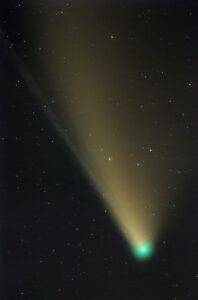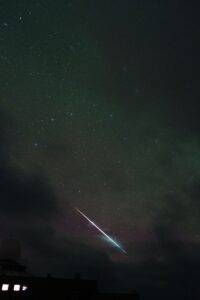A comet is a small, icy celestial body that orbits the sun and displays a bright coma (atmosphere) and a tail due to the vaporization of its ice by the sun’s heat. The composition of comets is a mixture of ice, dust, and small rocky particles, and they are thought to be remnants of the early solar system.
When a comet passes near the sun, its volatile materials are vaporized, creating the coma and tail that make it visible from Earth. Comets are thought to have originated in distant regions of the solar system, such as the Kuiper Belt and the Oort Cloud. These regions are believed to contain many leftover icy bodies from the early solar system that never coalesced into planets. Occasionally, the gravitational pull of a nearby planet or star will disturb these comets, sending them on a path towards the sun and making them visible from Earth as they warm up and release gas and dust.
Comets are considered to be time capsules, preserving the same materials and conditions from the early solar system. Studying comets can provide valuable insights into the conditions and processes that existed during the formation of the solar system.
The number of comets in our solar system is difficult to estimate, but it is believed to be in billions or trillions. The vast  majority of comets are located in the Kuiper Belt and the Oort Cloud, and only a small fraction of these comets have been observed by astronomers. As technology improves and our ability to detect comets increases, it is possible that we will discover many more comets in the future. However, the exact number is still uncertain and the study of comets is an active area of research.
majority of comets are located in the Kuiper Belt and the Oort Cloud, and only a small fraction of these comets have been observed by astronomers. As technology improves and our ability to detect comets increases, it is possible that we will discover many more comets in the future. However, the exact number is still uncertain and the study of comets is an active area of research.
on several factors, including its composition, the amount of ice and dust it contains, and its distance from the sun. The largest known comets, such as Halley’s Comet, can be several kilometres in diameter, while smaller comets may be only a few hundred meters across. It is important to note that the size of a comet’s coma and tail can be much larger than its nucleus, making it appear much larger than it actually is.
some comets are believed to contain various types of metals, including precious metals such as gold and platinum. These metals are thought to be remnants from the early solar system and are believed to have been present in the material that formed the sun and the planets. Scientists believe that studying comets can provide valuable insights into the conditions and processes that existed during the formation of the solar system, including the presence and distribution of various types of metals.
However, it is important to note that the amount of precious metals in a single comet is likely to be very small, making it unlikely that they would ever be mined for commercial purposes.
Comets can pass close to the sun, but it is unlikely that a comet would collide with the sun. The sun’s immense gravitational pull affects the orbit of nearby objects, including comets, but the chances of a comet actually hitting the sun are extremely small. Even if a comet were to collide with the sun, it would likely have a negligible effect on the sun’s overall structure and activity. The sun is so massive that a comet collision would be like a tiny pebble hitting a boulder. The sun has a diameter of over 1 million kilometres and its mass is approximately 330,000 times that of the Earth, making it extremely unlikely that a comet could cause any significant damage.
objects, including comets, but the chances of a comet actually hitting the sun are extremely small. Even if a comet were to collide with the sun, it would likely have a negligible effect on the sun’s overall structure and activity. The sun is so massive that a comet collision would be like a tiny pebble hitting a boulder. The sun has a diameter of over 1 million kilometres and its mass is approximately 330,000 times that of the Earth, making it extremely unlikely that a comet could cause any significant damage.
A green comet is a comet that displays a green colour in its coma or tail. The green colour is caused by the presence of gas in the coma and tail, which fluoresces when exposed to ultraviolet light from the sun. The most common gas responsible for the green colour is diatomic carbon (C2), which emits a green light when excited by ultraviolet radiation. Other gases, such as carbon monoxide (CO) and cyanogen (CN), can also contribute to the green colour.
It is relatively rare for a comet to display a green colour, as most comets are more commonly yellow or white. The green colour can provide valuable information about the composition of a comet and the processes that are taking place in its coma and tail.
The frequency with which green comets fly close to Earth varies greatly. Some green comets pass close to Earth infrequently, only once every few hundred or thousand years, while others may never come close to Earth at all. The exact frequency with which a green comet passes near Earth depends on several factors, including its orbit, the gravitational pull of nearby celestial bodies, and the amount of time it has been in the solar system.
It is also worth noting that not all green comets that pass near Earth will be visible from the surface. The visibility of a comet depends on several factors, including its brightness, the phase of the moon, and the presence of light pollution. However, when a green comet is visible from Earth, it can be a spectacular sight, with its bright green coma and tail making it a memorable event for those who are able to observe it.
As of now, there is no concrete evidence of life  on comets. The conditions on comets are extremely harsh, with low temperatures, no atmosphere, and constant bombardment from cosmic rays and solar wind. These conditions make it very difficult for life as we know it to exist on comets. However, the discovery of organic molecules in comets, including amino acids and other building blocks of life, has led some scientists to speculate that comets may have played a role in the origin of life on Earth. It is believed that comets may have delivered water and organic molecules to the early Earth, helping to create the conditions necessary for life to emerge.
on comets. The conditions on comets are extremely harsh, with low temperatures, no atmosphere, and constant bombardment from cosmic rays and solar wind. These conditions make it very difficult for life as we know it to exist on comets. However, the discovery of organic molecules in comets, including amino acids and other building blocks of life, has led some scientists to speculate that comets may have played a role in the origin of life on Earth. It is believed that comets may have delivered water and organic molecules to the early Earth, helping to create the conditions necessary for life to emerge.
Despite this, the existence of life on comets is still purely speculative and further study is needed to determine whether life is possible on these icy bodies. As our understanding of comets and the conditions in the early solar system continues to improve, it may be possible to determine more conclusively whether life exists or could have existed on comets.
The Earth can be hit by comets and other celestial objects such as asteroids. While the chances of a significant impact are relatively small, such events have occurred in the past and can have significant consequences for the Earth and its inhabitants. Comets and asteroids are constantly entering the Earth’s orbit and passing close to the planet. Most of these objects are small and burn up upon entering the Earth’s atmosphere, causing little or no damage. However, larger objects can impact the Earth and cause significant damage, including widespread fires, tsunamis, and even mass extinctions.
To mitigate the risk posed by potential impact events, scientists and governments around the world are working to identify potentially hazardous objects and to develop plans to prevent or deflect them if necessary. By monitoring the sky and tracking the movements of comets and asteroids, we can better understand the potential risks posed by these objects and take the necessary steps to protect the Earth and its inhabitants. The last known time a significant comet impacted the Earth was approximately 66 million years ago, when a large comet or asteroid is believed to have struck the planet, causing the mass extinction of the dinosaurs and many other species.
governments around the world are working to identify potentially hazardous objects and to develop plans to prevent or deflect them if necessary. By monitoring the sky and tracking the movements of comets and asteroids, we can better understand the potential risks posed by these objects and take the necessary steps to protect the Earth and its inhabitants. The last known time a significant comet impacted the Earth was approximately 66 million years ago, when a large comet or asteroid is believed to have struck the planet, causing the mass extinction of the dinosaurs and many other species.
There have been smaller comet impacts on the Earth in more recent times, but these events have not caused widespread damage or extinction. For example, in 2013, a comet named ISON passed close to the Earth and was visible from the ground, but it did not impact the planet. It is important to note that the impact of a comet on the Earth is a rare event and that the likelihood of a significant impact in the near future is small. However, scientists and governments continue to monitor the sky and track the movements of comets and other celestial objects in order to better understand the potential risks and to take necessary precautions if needed.
The Tunguska event was a large explosion that occurred near the Tunguska River in Russia in 1908. The exact cause of the explosion is still a matter of debate, but most scientists believe that it was caused by the impact of a comet or a meteoroid.
The Tunguska event was one of the largest impact events in recorded history and caused widespread damage to the forest in the area, levelling over 800 square miles (2,000 km2) of trees. Despite the magnitude of the explosion, there were no reported human fatalities, as the area was sparsely populated. The Tunguska event serves as a reminder of the potential hazards posed by comets and other celestial objects and highlights the importance of monitoring the sky and tracking the movements of these objects in order to understand the potential risks and take necessary precautions if needed.
It is not possible to completely guarantee the safety of life on Earth from the threat of comet impacts. However, the likelihood of a significant impact is relatively small, and scientists and governments around the world are working to monitor the sky and track the movements of comets and other celestial objects in order to better understand the potential risks and to take necessary precautions if needed.
The impact of a comet on the Earth is a rare event, and the majority of comets and other celestial objects that enter the Earth’s orbit are small and burn up upon entering the Earth’s atmosphere, causing little or no damage. In addition, the Earth’s atmosphere provides a protective barrier against smaller objects, reducing the risk of damage from impacts.
While it is not possible to completely guarantee the safety of life on Earth from comet impacts, ongoing efforts to monitor and understand the potential risks posed by these objects can help to mitigate the dangers and to ensure the safety of life on our planet.
If a person were to discover a piece of a comet, they should not handle it as it may contain potentially harmful materials such as ice, dust, and gas. Instead, they should immediately report the discovery to a local astronomer, a museum, or a science organization, who can then take the necessary steps to collect and study the sample.
It is important to remember that comets are considered to be scientifically valuable and valuable and that the discovery of a piece of a comet is a rare event. By reporting the discovery and allowing professionals to handle the sample, the person can help to advance our understanding of these objects and contribute to our knowledge of the solar system and the universe.
Additionally, it is important to follow all applicable laws and regulations when handling potential samples from comets or other celestial objects. In some countries, it may be illegal to remove and retain a piece of a comet without proper authorization.
The ownership of a piece of a comet can too depend on the laws and regulations of the country in which it is discovered. In some countries, celestial objects and their material are considered to be the property of the state, and it may be illegal to remove or retain a piece of a comet without proper authorization. In other countries, private ownership of celestial objects may be recognized, but ownership may be subject to specific conditions and restrictions.
It is important to follow all applicable laws and regulations when handling potential samples from comets or other celestial objects. Failure to do so can result in legal consequences, including fines and imprisonment.
If you have discovered a piece of a comet and are uncertain about the laws and regulations in your area, it is recommended that you seek advice from a local astronomer, museum, or science organization, who can provide guidance and information on the appropriate steps to take.
Comets can contain materials that may pose a threat to life on Earth. Some comets contain volatile substances such as hydrogen cyanide, which can be harmful if released into the Earth’s atmosphere in large quantities. In addition, the impact of a comet on the Earth’s surface can release large amounts of dust and gas, which can disrupt the Earth’s atmosphere and potentially have harmful effects on the planet’s climate and ecosystems.
However, the likelihood of a significant impact is relatively small, and the majority of comets and other celestial objects that enter the Earth’s orbit are small and burn up upon entering the Earth’s atmosphere, causing little or no damage. In addition, the Earth’s atmosphere provides a protective barrier against smaller objects, reducing the risk of damage from impacts.
It is important to continue to monitor the sky and track the movements of comets and other celestial objects in order to better understand the potential risks and to take necessary precautions if needed. Ongoing efforts to monitor and understand the potential risks posed by these objects can help to mitigate the dangers and to ensure the safety of life on our planet.
